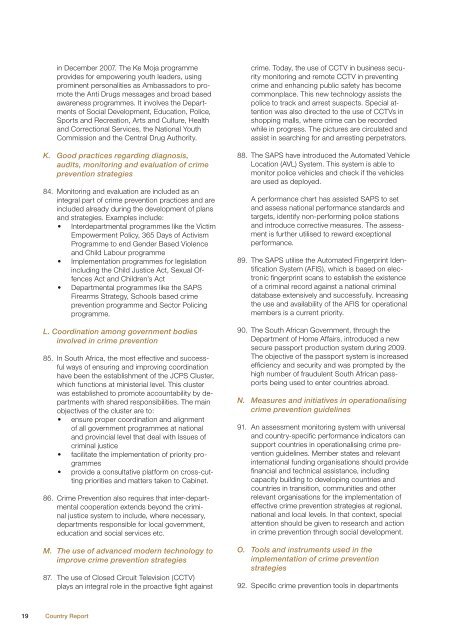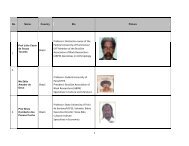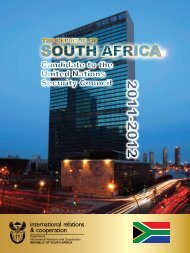Read more - Department of International Relations and Cooperation
Read more - Department of International Relations and Cooperation
Read more - Department of International Relations and Cooperation
Create successful ePaper yourself
Turn your PDF publications into a flip-book with our unique Google optimized e-Paper software.
in December 2007. The Ke Moja programme<br />
provides for empowering youth leaders, using<br />
prominent personalities as Ambassadors to promote<br />
the Anti Drugs messages <strong>and</strong> broad based<br />
awareness programmes. It involves the <strong>Department</strong>s<br />
<strong>of</strong> Social Development, Education, Police,<br />
Sports <strong>and</strong> Recreation, Arts <strong>and</strong> Culture, Health<br />
<strong>and</strong> Correctional Services, the National Youth<br />
Commission <strong>and</strong> the Central Drug Authority.<br />
K. Good practices regarding diagnosis,<br />
audits, monitoring <strong>and</strong> evaluation <strong>of</strong> crime<br />
prevention strategies<br />
84. Monitoring <strong>and</strong> evaluation are included as an<br />
integral part <strong>of</strong> crime prevention practices <strong>and</strong> are<br />
included already during the development <strong>of</strong> plans<br />
<strong>and</strong> strategies. Examples include:<br />
• Interdepartmental programmes like the Victim<br />
Empowerment Policy, 365 Days <strong>of</strong> Activism<br />
Programme to end Gender Based Violence<br />
<strong>and</strong> Child Labour programme<br />
• Implementation programmes for legislation<br />
including the Child Justice Act, Sexual Offences<br />
Act <strong>and</strong> Children’s Act<br />
• <strong>Department</strong>al programmes like the SAPS<br />
Firearms Strategy, Schools based crime<br />
prevention programme <strong>and</strong> Sector Policing<br />
programme.<br />
L. Coordination among government bodies<br />
involved in crime prevention<br />
85. In South Africa, the most effective <strong>and</strong> successful<br />
ways <strong>of</strong> ensuring <strong>and</strong> improving coordination<br />
have been the establishment <strong>of</strong> the JCPS Cluster,<br />
which functions at ministerial level. This cluster<br />
was established to promote accountability by departments<br />
with shared responsibilities. The main<br />
objectives <strong>of</strong> the cluster are to:<br />
• ensure proper coordination <strong>and</strong> alignment<br />
<strong>of</strong> all government programmes at national<br />
<strong>and</strong> provincial level that deal with Issues <strong>of</strong><br />
criminal justice<br />
• facilitate the implementation <strong>of</strong> priority programmes<br />
• provide a consultative platform on cross-cutting<br />
priorities <strong>and</strong> matters taken to Cabinet.<br />
86. Crime Prevention also requires that inter-departmental<br />
cooperation extends beyond the criminal<br />
justice system to include, where necessary,<br />
departments responsible for local government,<br />
education <strong>and</strong> social services etc.<br />
M. The use <strong>of</strong> advanced modern technology to<br />
improve crime prevention strategies<br />
87. The use <strong>of</strong> Closed Circuit Television (CCTV)<br />
plays an integral role in the proactive fight against<br />
crime. Today, the use <strong>of</strong> CCTV in business security<br />
monitoring <strong>and</strong> remote CCTV in preventing<br />
crime <strong>and</strong> enhancing public safety has become<br />
commonplace. This new technology assists the<br />
police to track <strong>and</strong> arrest suspects. Special attention<br />
was also directed to the use <strong>of</strong> CCTVs in<br />
shopping malls, where crime can be recorded<br />
while in progress. The pictures are circulated <strong>and</strong><br />
assist in searching for <strong>and</strong> arresting perpetrators.<br />
88. The SAPS have introduced the Automated Vehicle<br />
Location (AVL) System. This system is able to<br />
monitor police vehicles <strong>and</strong> check if the vehicles<br />
are used as deployed.<br />
A performance chart has assisted SAPS to set<br />
<strong>and</strong> assess national performance st<strong>and</strong>ards <strong>and</strong><br />
targets, identify non-performing police stations<br />
<strong>and</strong> introduce corrective measures. The assessment<br />
is further utilised to reward exceptional<br />
performance.<br />
89. The SAPS utilise the Automated Fingerprint Identification<br />
System (AFIS), which is based on electronic<br />
fingerprint scans to establish the existence<br />
<strong>of</strong> a criminal record against a national criminal<br />
database extensively <strong>and</strong> successfully. Increasing<br />
the use <strong>and</strong> availability <strong>of</strong> the AFIS for operational<br />
members is a current priority.<br />
90. The South African Government, through the<br />
<strong>Department</strong> <strong>of</strong> Home Affairs, introduced a new<br />
secure passport production system during 2009.<br />
The objective <strong>of</strong> the passport system is increased<br />
efficiency <strong>and</strong> security <strong>and</strong> was prompted by the<br />
high number <strong>of</strong> fraudulent South African passports<br />
being used to enter countries abroad.<br />
N. Measures <strong>and</strong> initiatives in operationalising<br />
crime prevention guidelines<br />
91. An assessment monitoring system with universal<br />
<strong>and</strong> country-specific performance indicators can<br />
support countries in operationalising crime prevention<br />
guidelines. Member states <strong>and</strong> relevant<br />
international funding organisations should provide<br />
financial <strong>and</strong> technical assistance, including<br />
capacity building to developing countries <strong>and</strong><br />
countries in transition, communities <strong>and</strong> other<br />
relevant organisations for the implementation <strong>of</strong><br />
effective crime prevention strategies at regional,<br />
national <strong>and</strong> local levels. In that context, special<br />
attention should be given to research <strong>and</strong> action<br />
in crime prevention through social development.<br />
O. Tools <strong>and</strong> instruments used in the<br />
implementation <strong>of</strong> crime prevention<br />
strategies<br />
92. Specific crime prevention tools in departments<br />
19 Country Report

















